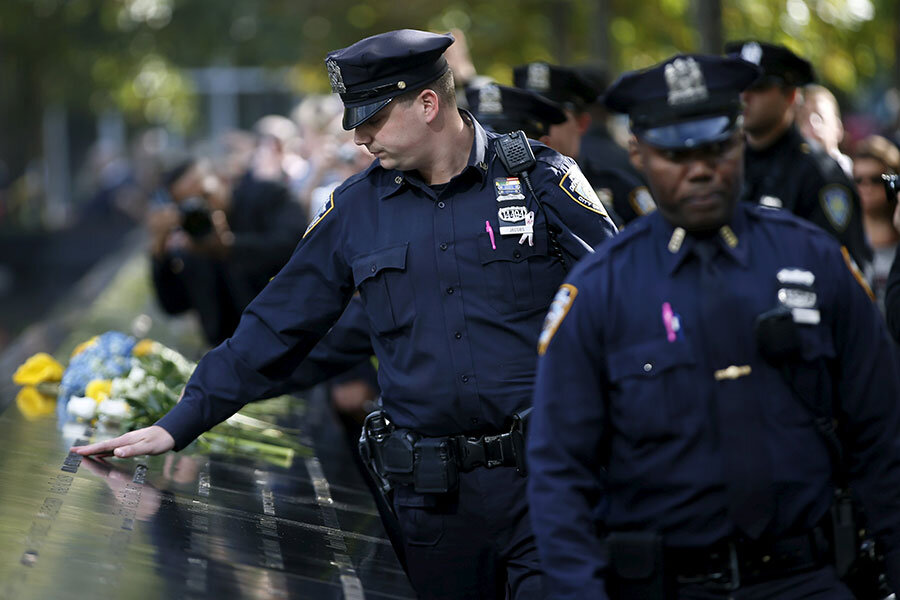In New York, death of another officer kindles deeper debate
| New York
Last week, New York Police Commissioner Bill Bratton joined more than 130 of the nation’s top officials to argue that offering drug and alcohol treatment, rather than jail time, would be more likely to help offenders improve and reintegrate into society.
The group’s mission statement, released Tuesday, said: “With momentum for criminal justice reform accelerating, we want to leave no doubt where the law enforcement community stands: We need less incarceration, not more, to keep all Americans safe.”
By that night, however, the headlines had shifted. A convicted drug dealer who avoided jail only because he was eligible for a court-supervised rehab program was arrested and charged with killing a New York police officer, Randolph Holder.
The past week has been a difficult and emotional one for New York as the city mourns a fallen officer for the fourth time in less than a year. Even the famously liberal Mayor Bill de Blasio angrily called on state lawmakers to reform New York’s progressive sentencing reforms, criticizing the diversion program that kept the suspect out of jail.
“So we’ve got to have the maturity to look at both sides of the equation,” Mayor de Blasio said last week. “We don’t want to give up on redeeming people who can be redeemed.... But we also have to recognize that some people are just hardened criminals.”
The incident shows how difficult and politically precarious it can be to reduce sentences and find alternatives to jail time, even as officials across the nation try to address a burgeoning prison population, the biggest in the world.
Reduced sentences and alternatives to incarceration have been widely discussed during the past few years, receiving widespread bipartisan support. The Justice Department is about to begin releasing some 6,000 federal prisoners whose sentences had been retroactively reduced by new guidelines by the United States Sentencing Commission.
As many as 40,000 federal prisoners may have their sentences reduced in the next few years, experts say, raising concerns that cases such as the one in New York could multiply.
“From our perspective, this is a really unfortunate case, but an outlier,” says Julie Netherland, deputy state director of the Drug Policy Alliance in New York. “And this is the first kind of tragedy like this that we’ve seen emerge. It would be a shame for this one tragic incident to undo all the good work and progress that has been made.... We’re at a point in this country where people are really rethinking the war on drugs and the need to lock up tens of thousands of people in this country.”
De Blasio has called for “common sense reforms” to the 6-year-old diversion program, put in place in 2009 when New York reformed its notoriously harsh 1970s-era drug laws. De Blasio also questioned the state’s bail procedures, which he said are based solely on risk of flight rather than the possible dangers a suspect may pose.
But critics say the mayor has been too quick to challenge the diversion program and has not characterized the program correctly – showing the dangers of misinformation in such circumstances. In fact, on the issue of bail, the law calls for judges to hear evidence on whether institutional confinement may be necessary for the protection of the public.
Though the suspect had been arrested numerous times and convicted of repeated drug dealing – and allegedly connected to an earlier shooting – a judge found him eligible for the program since he had not been convicted of a violent crime.
Manhattan Supreme Court Justice Edward McLaughlin told The New York Post that the suspect fit the strict parameters for the program, citing the suspect's drug addiction and his common-law wife and two children.
But with thousands being considered for such programs, single cases should not undermine a broader policy, he suggested.
“I know I made the right decision,” he said. “I don’t get a crystal ball when I get a robe. If I wanted to avoid being in the papers I could probably accomplish that by doing nothing but [make] decisions designed to give myself cover and excuses,” he said. “I don’t know. I hope other judges don’t act that way.”







